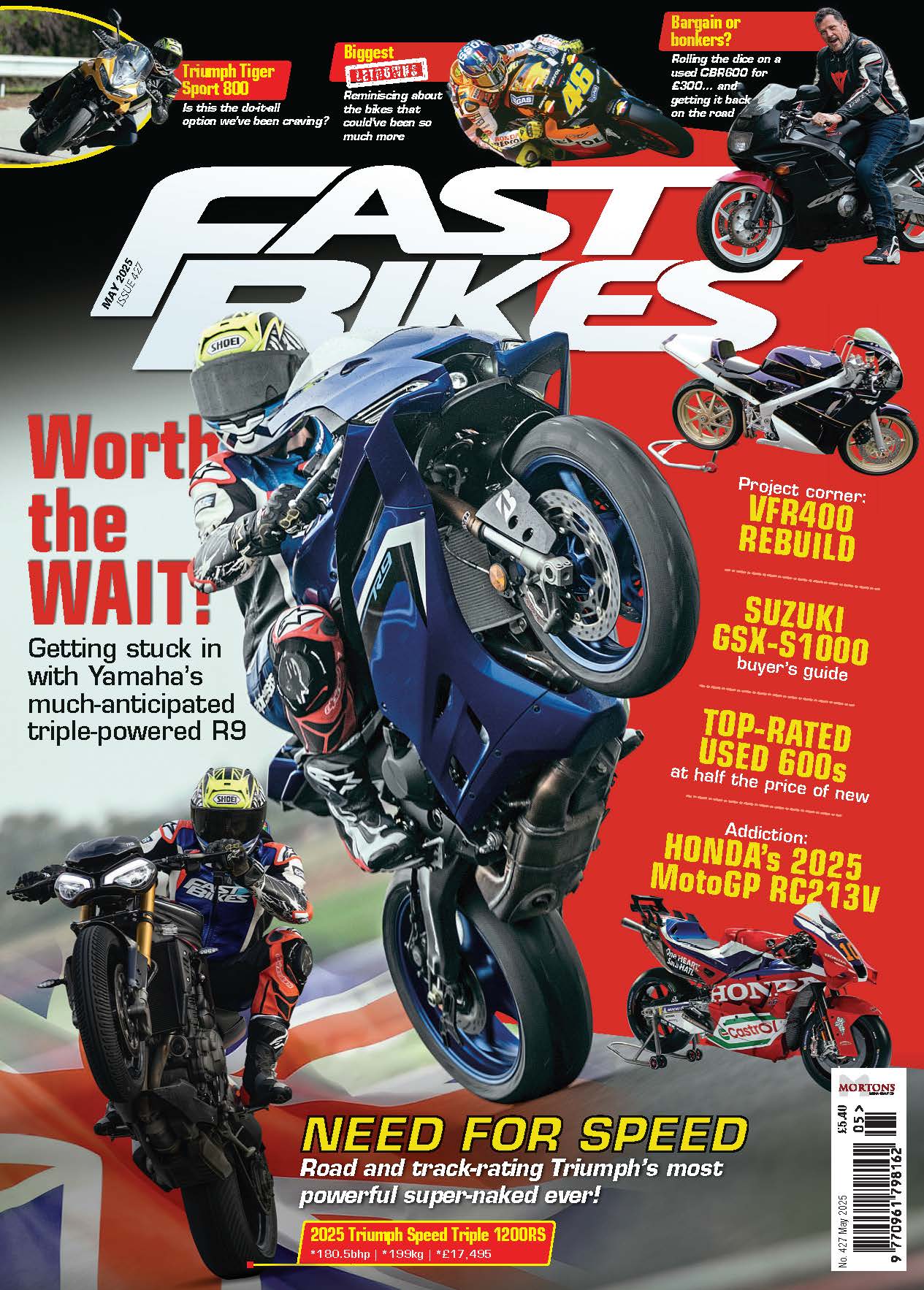In a world rammed with super trick, super fast and super saucy motorcycles, what does it take to be defined as truly ‘special’? We ponder that question, then offer up some of best bikes we’ve ever ridden…

Words: Big Mac/ Dangerous Pics: Chappo
Straight away I want to acknowledge that most of what of what you’re about to read leaves me on extremely thin ice, and open to a lot of head shaking and tutting from people who probably know better than me on the subject of special bikes… or at least have a greater passion on the subject than me. The problem is that the whole topic is highly subjective, and therefore open to all sorts of interpretations. For starters, just how to define one bike more special than another is a problem. Is it the price tag? If so, that would rule out the humble Honda C90, a bike on which the entire Honda Motor company was built on, and without which we wouldn’t have things like RC30s, Fireblades, NR750s or RCVs. Maybe the C90 and other humble bikes without which there would be no uber-bikes, are “just” a significant bike rather than a special bike – and this is why the subject is so open to disagreement. A special bike to one person is just some stickers and plaque on the headstock to another person.
There are, however, some rules of thumb which can be considered safe ground when it comes to the subject, and one of them is that it doesn’t actually have to be any good to ride. For example, I’ve been lucky enough to ride a couple of Ducati Desmosedicis on the road, a bike that was presented as a replica of their GP06 but in reality is more of a tribute to the MotoGP bike to raise money to fund the MotoGP program, sharing only it’s bore and stroke and the cylinder head base bolts from the GP06. Ducati’s own 1098 from the same year was a much better bike to ride, but the “Desmo” is the iconic, special, desirable one that today commands daft money. Also, you can add pretty much any Bimota from the 90s and 00s as examples of bike which are at best average to ride yet have that “thing” some call “X-Factor”.
It helps massively if a bike is produced in limited numbers, and the smaller the better. It took KTM just 45 minutes to sell the 500 SuperDuke RR’s which they made available to the world when they announced it, probably because they made it clear that there would only ever be 500. There’s just five of Kawasaki’s homologation special ZX-6RR M1-Hs on the road in the UK, which admittedly is a bit of an anoraks bike, but at the very least does make it way more special than not only every other ZX-6R, but every other 600 supersport bike ever made. As featured more recently in Fast Bikes, Ducati only produced 630 of their Street fighter V4 “Lamborghini” edition which people are already falling over themselves to pay nearly double what Ducati did in the first instance. “Supply and Demand” is the oldest trick in the book for making something more desirable than it probably deserves to be, and therefore special. The fact that the Lambo Ducati and ZX-6RR aren’t any better than the bikes their based on is irrelevant, and proof of this.


Sometimes we get bikes that give us a rare insight into what their designers would actually like to have made if it wasn’t for those pesky accountants and company shareholders; bikes get the sign off for no other reason than corporate willy waving. I’m thinking Ducati’s Superleggeras, Honda’s RCV213V-S and NR750, Kawasaki’s H2 and H2-R, Bimota’s Tesi and BMW’s carbon fibre framed HP4 Race off the top of my head. Statement bikes designed and produced with an open cheque book for the engineers so that all the best materials can be used, all the best components, and if they want to experiment with oval pistons or carbon frames and design and build your own supercharger, then they can. Bikes that only happens when the shackles of profit and loss are not in the room, and anything goes, no matter the cost… which is why inevitably not many ever get produced. They’re usually violently expensive, and often make the company a loss, so only enough are made in order to get the desired headlines, which is why sometimes such bikes get funded by the marketing department as well as the usual R&D department – there is usually a line that can be drawn between such bikes, and a manufacturer’s brand values. They’re referred to as “Halo Bikes” by the manufacturers.
Homologation bikes are notoriously fickle when it comes to capturing the imagination of the public, and it’s usually a combination of how successful that bike is/was on track, and how geeky you have to be to appreciate it – see previous example of the ZX-6RR M1H. A couple of great examples would be Honda’s RC30 and its successor the RC45. It’s night and day between them when it comes to desirability and therefore special-ness, as it is with Ducati’s 916 and 999, while trick homologation specials such as the Kawasaki ZXR750-RR, Suzuki’s GSX-R750RR, Yamaha’s OWO1 and OWO2 (R7) never really caught the imagination of buyers.
Then there’s a massive grey area of bikes which are not much more than some trinkets and stickers added to an existing bike which then gets produced in small numbers and called a “Special Edition”. These bikes often irritate the hell out of me for being cynical and clearly a move by the manufacturer to shift some slow moving stock. Ducati went through a phase of putting a few carbon bits on a bike, and maybe an end can, then calling it an “SP”, and Suzuki painted a lot of GSX-Rs in their MotoGP colours when it was clear they were about to discontinue the GSX-R, and more recently Kawasaki have announced some 40th Anniversary of the “Ninja”, by releasing the ZX-10RR, ZX-6R and ZX-4RR in some paint jobs from the 90s, and last year Honda gave us the “McGuinness” Fireblade. The thing about these bikes is that while most of them are just the manufacture needing to shift unsold units – which I don’t have a problem with by the way – some are very clever and press all the right buttons to make an otherwise unloved bike suddenly very desirable. If the message is right, or it’s a nod to better times, a tribute or special bike can appeal very strongly to our emotions, which after all are the hook that gets us to part with our money for anything motorbike related.
The McGuinness Fireblade is one such bike as it celebrates a truly remarkable achievement by the hugely popular TT legend John McGuinness. This is Honda acknowledging their man in a very classy, simple but high quality way, by producing a colour scheme precisely the same as the one McGuinness used for his 100th TT start at the 2022 Isle of Man TT races.
He only raced in the colour scheme for the first Superbike race that year – his 100th TT start – and his 5th place finish in that race was his best result at the TT since 2016. At one point during the race, he was as high as 4th, and he set a best lap of 129.4MPH during the six-lap race. While the fairy-tale podium wasn’t to be, I was one of the lucky ones to be on the grid for that race as I was working for Bathams Racing for Rutter who had the start number 3, and therefore only a couple of bikes behind McGuinness. There wasn’t a dry eye in the house when McGuiness got the race underway, and then later returned to parc-ferme at the end. It was a genuinely significant milestone because only three other people have ever started 100 TTs. It was a genuinely emotional day for a lot of people, and there was a enormous amounts of respect and appreciation deservedly heaped on McGuinness that day by all of the racing community.



For the TT geeks amongst us, I like to think that the gesture from Honda to McGuinness to produce a run of 30 special edition Fireblades in his name goes even deeper than the 100 starts, and so it should when you realise just how significant the McGuiness/Fireblade marriage has been at the TT over the years. The Fireblade has won 21 TT races in its time, and McGuinness is responsible for 12 of them. For perspective, the next most successful rider at the TT on a Fireblade is Ian Hutchinson with “only” 4 wins. Spookily the Fireblades first win at the TT was Hondas 100th TT start in the 1998 production TT in the hands of Jim Moodie, but I digress…
Back to the McGuinness/Fireblade love affair, and it’s also worth remembering that the first ever 130MPH lap of the TT course was… you guessed it… McGuinness on a Fireblade in 2007. So, when McGuinness returned to Honda after a few years at Norton, and a couple at Kawasaki – which coincided with the Covid cancelled TTs – this McGuinness Fireblade doesn’t just celebrate McGuinness’s 100 TT starts as Honda have presented it, but thanks to the wonders of coincidence, that 100th TT start was also McGuiness’s first race back with Honda after his brief hiatus in silver, then green.
In terms of what you get or rather got – as they’re all sold – for your £30,000, which is £7000 more than a standard Fireblade 30th Anniversary edition, there’s a carbon mudguard and hugger, a pillion seat cover, taller “TT style” screen, gold pin stripes on the wheels which are fitted with Metzeler Racetecs for full authenticity as McGuiness is sponsored by Metzeler. The tank cover is signed by McGuinness, there’s the obligatory serial number on the top yoke, a garage mat, dust cover, and if you really wanted, you could have your bike handed over to you by the man himself at the Honda Racings workshop in Louth.
However, it’s the paint scheme that is the thing which really matters, as it’s the thing above all else which pays tribute to McGuinness and his incredible achievement at the TT. It’s not a sticker kit slapped on a Fireblade, it’s a genuinely heartfelt homage from the world’s largest motorcycle manufacturer that’s packed with painstaking details such as a photo of every one of McGuiness’s previous 99 TT starts, and it is perfectly identical to his race bikes paint scheme for that 100th start.
All of the things that are on the bike don’t or shouldn’t add anything to how the bike rides. There’s nothing there that would dynamically change how the bike behaves or increase its performance, except possibly the tyres, but there’s also the “special-ness” factor, which only riding it can tell you if it exists. Over to Bruce…
Honda Fireblade CBR1000RR-R SP John McGuinness TT Replica…
Words: Dangerous Pics: Chappo
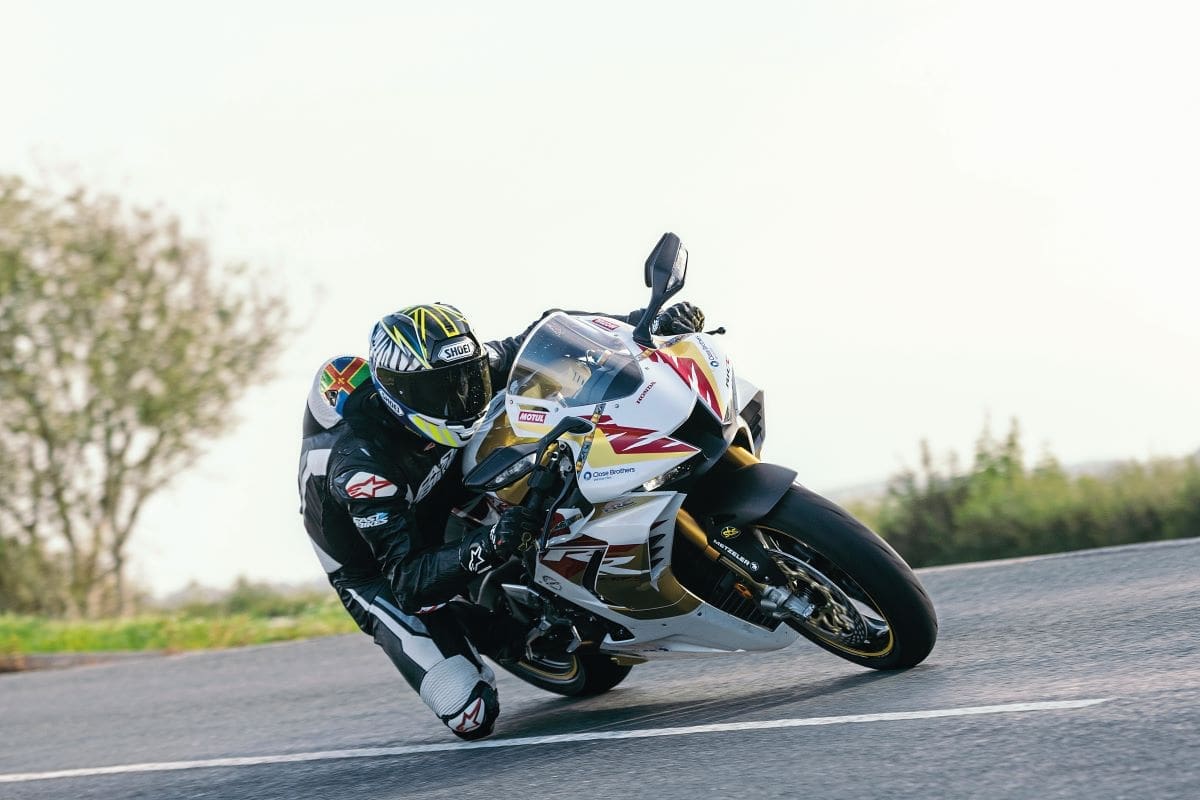
Have you ever found yourself in two minds, arguing with your own thoughts as to whether something is better, worse, or simply indifferent? Is it worth paying an extra 70p for the specially dried Columbian virgin coffee beans from your local barista, or does the run-of-the-mill stuff they serve taste just as good, at half the price? Can you really tell the difference, or are a few sexy words scrambling your brain into thinking something is simply better because it costs more?
The reason for this tangent is to give context to the Blade and my relationship with it. It is a bike I know well, having not only been on the latest iteration’s launch back in 2020 under a roasting Qatari sun, but also going on to clock 5000 miles on my termer that very same year. In 2022, I was there on the launch of the updated 30th anniversary model, on track with a certain Mr McGuinness, and only last year that same bike powered me through some unforgettable riding experiences on the Isle of Man. The Blade is one of my favourite motorcycles of all time, made so alluring by its precise and informative front end and its mind-warpingly fast and exciting motor. It is an absolute beast to ride – a literal testament to Honda’s engineering prowess that’s translated to many wins on the racetrack, and which is sure to power a fair few more in the months ahead (albeit it on the newer, tricker 2024 spec machine).
But here is my quandary… why is the McGuinness bike any better than the 30th anniversary SP, which in itself is a looker and comes fully loaded with about 95% of the components you’ll find on this limited edition? That question rattled around my grey matter as I blasted along my favourite backroads, getting reacquainted with this compact pocket rocket.
And there lies the problem. Within five miles, I was back on a Blade. Albeit a special-looking Blade, but the same Honda I knew and loved. Its handling was just as lithe, it felt entirely just as cramped, and featured the same awkward switchgear that takes you all of a day to stop thumbing the horn instead of the indicator. For all the glitz, glam and added shiny bits, the McGuinness machine felt a mirror image of all the 2022-plus examples I’ve ever ridden – and there was nothing wrong with that. More to the point, what the hell had I been expecting to experience? Well, for six grand more, a fair bit, being honest. Only because as much as I like John McGuinness, I think even he’d stop short of spending that much extra on a bike because of a fancy paintjob, which is largely the hook to owning this machine. Yep, the rational part of my brain was soon arguing that the rep was a rip-off, with the only tangible riding difference between this and its different colour-schemed brethren being the aftermarket system that my mate Alan, who owns this example, had got fitted to the bike. Weighing in at about £3000, the full titanium Akrapovic on this thing delivered the most heavenly of noises, allowing the Honda’s motor to breathe and bark on a level the stock silencer simply didn’t allow for. It also meant this bike was packing more ponies than standard, with better fuelling throughout. Just as importantly, the system looked the nuts and only added to the package of appeal on show. I am a sucker for eye candy, I admit, and while the exhaust was a high point of the bike’s appearance, it wasn’t the only one. Like Johnny, I was at the TT when McGuinness rolled this centenary special out of his garage and headed off down Glencrutchery Road. It was a truly extraordinary moment and, in the flesh, his superbike looked a million dollars, befitting of such a momentous occasion. I’ll never forget it – and that’s why the allure of this bike was overwhelming my penny-pinching tightness at every corner. How do you put a price on something so special? With every mile clocked, I’d be a liar to not admit I spent 50% of the time taking in the bike’s colours, details, and laser-etched plaque on the top yoke, encompassing John’s signature next to an outline of the TT course. I liked what I saw, and so began this weird battle in my mind as to why this bike was so special, despite it being similar to the other Blades.
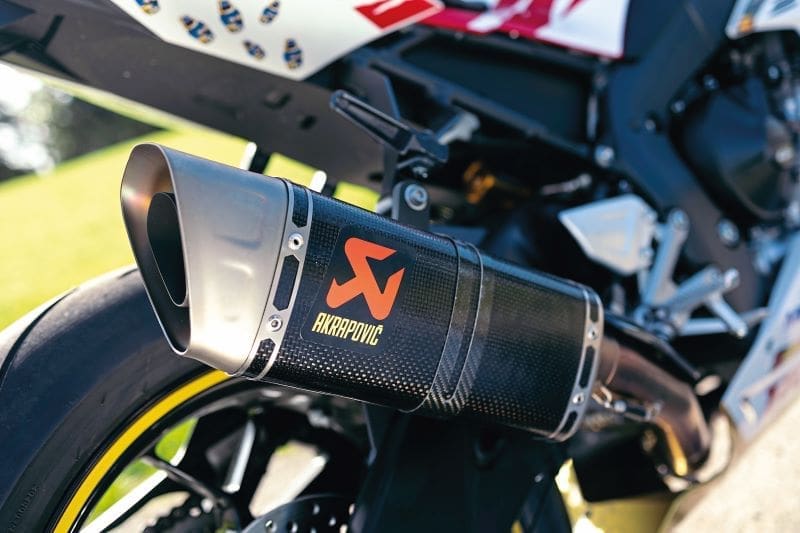


I rode a good few miles on it that day, pulling up at Cadwell for a coffee (non-special beans), where a crowd of people formed to take the bike in, pointing at the pictures, the plaque, and the colours. It was a crowd-pleaser, which in turn pleased me to witness it provoking so much excitement and adoration. Not every bike does that… at least, not on a level like this. In fact, I’ve ridden far pricier bikes that’ve failed to capture the attention the McGuinness rep did. I felt a bit of a humbug, eventually striding over and riding the bike away from the masses. I daresay it was the first of the 30 special versions that they’d ever seen, and when the run is limited to that extent, chances are they’ll not see another one again in a hurry.
That’s actually what makes this bike special. It’s not the riding experience, but the meaning behind the resplendent-looking bodywork that quantifies this bike as being extraordinary. It’s a tribute to a legend and a moment in time that will never be repeated. But there’s another aspect here that’s maybe not so obvious, but which is likely to come true for the lucky few who snapped up their slice of exotic Blade. Yes, this bike will set you back £6k more than an arguably very similar version of the same motorcycle, but if I were to bet my hat on which one would best hold its money, it’d be the McGuinness Blade all day long. If history is anything to go by, don’t be surprised to find that the price starts creeping upwards of the original sale price, especially those which have been bought by collectors to litter their hallways or office blocks in the style of fine end furnishings. Just imagine, even in 10 years’ time, what the going rate will be on a zero-mile John McGuinness Centenary replica? Well, your guess is as good as mine, but it won’t be thirty grand.
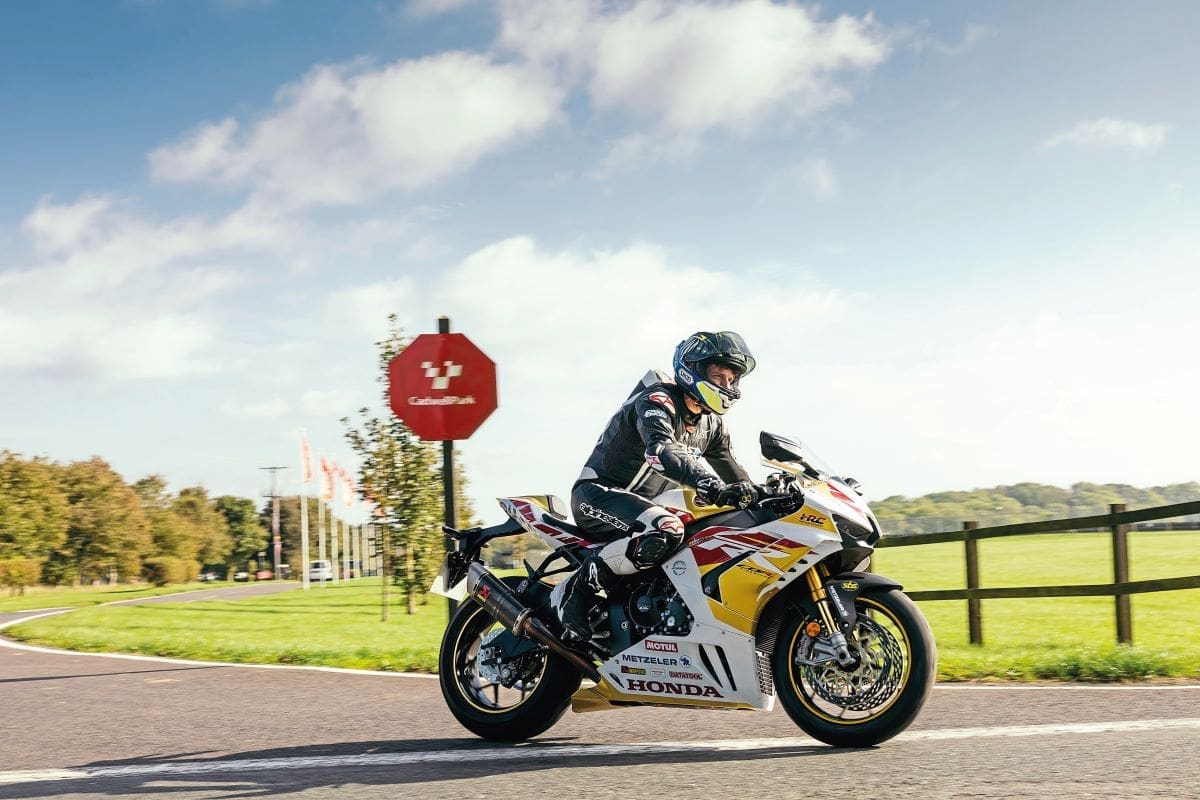
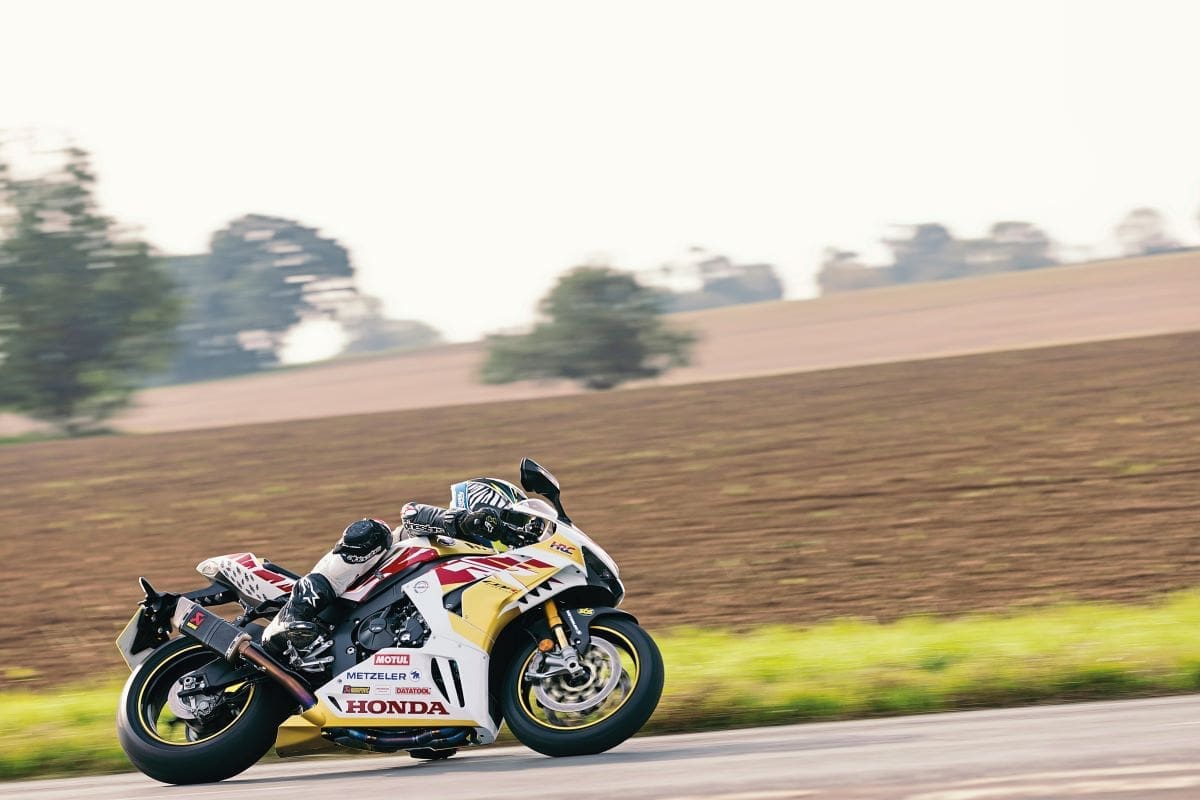

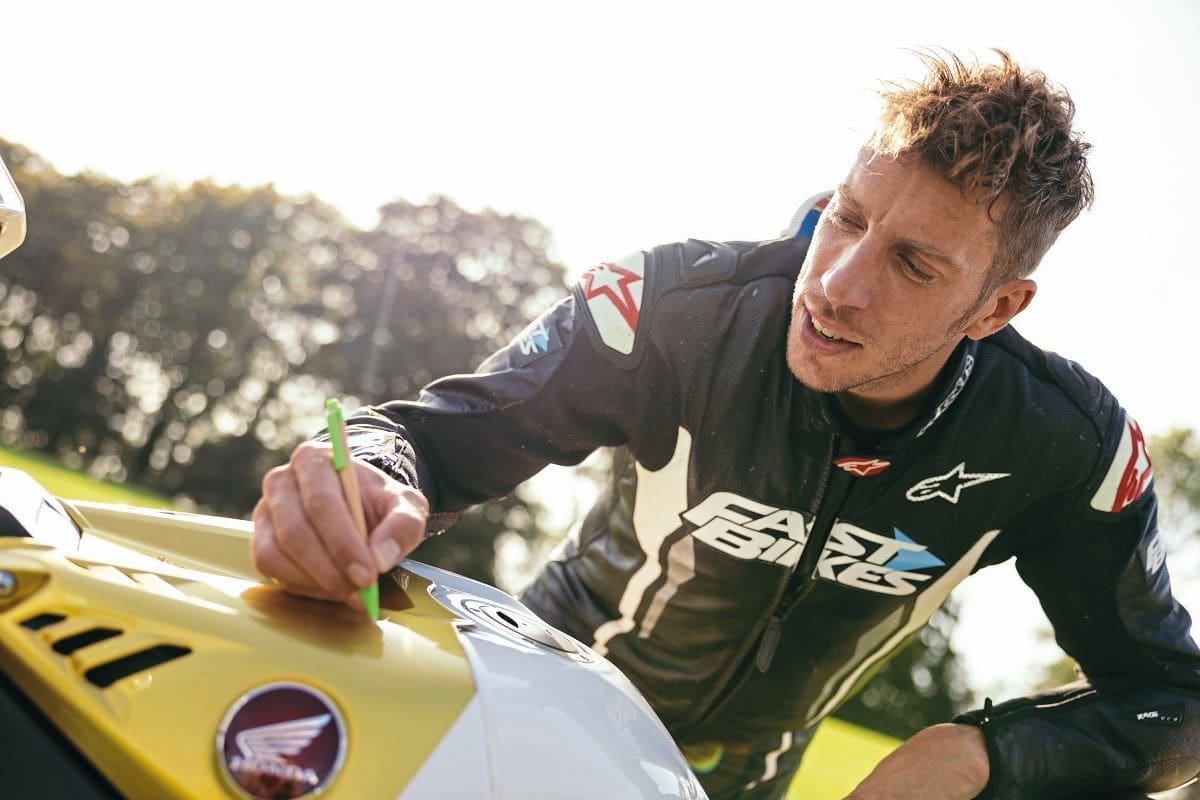
Tech Data
Honda Fireblade RR-R SP
McGuinness TT Replica
Engine:
Type: 999.9cc, liquid-cooled, in-line-four
Bore x stroke: 81mm x 48.5mm
Compression: 13.0:1
Fuelling: EFI
Claimed power: 214bhp @ 14,500rpm
Claimed torque: 113Nm @ 12,500rpm
Chassis:
Frame: Aluminium diamond
F suspension: 43mm Öhlins NPX Smart-EC forks USD forks
R suspension: Öhlins TTX36 Smart-EC monshock
Front brakes: Four-pot Brembo Stylema calipers, 330mm discs
Rear brake: Two-piston Bremobo caliper, 220mm disc
Electronics.
Riding modes: Yes
Traction control: Yes
ABS: Yes
Quickshifter: Yes
Autoblipper: Yes
Wheelie control: Yes
Launch control: Yes
Dimensions:
Wheelbase: 1455mm
Seat height: 830mm
Wet weight: 201kg
Fuel capacity: 16 litres

